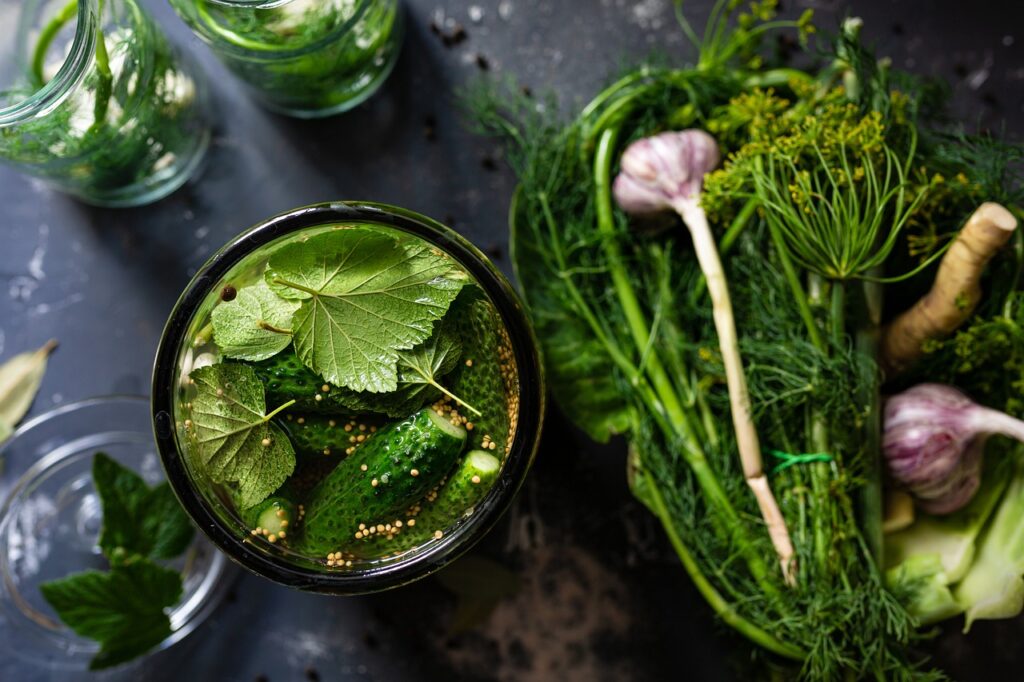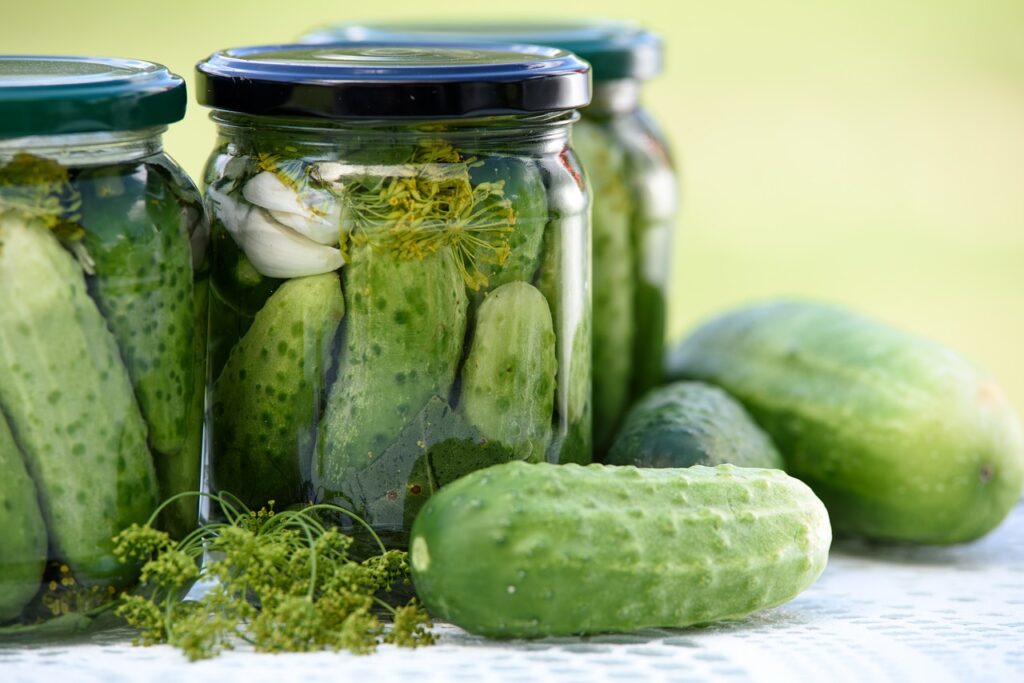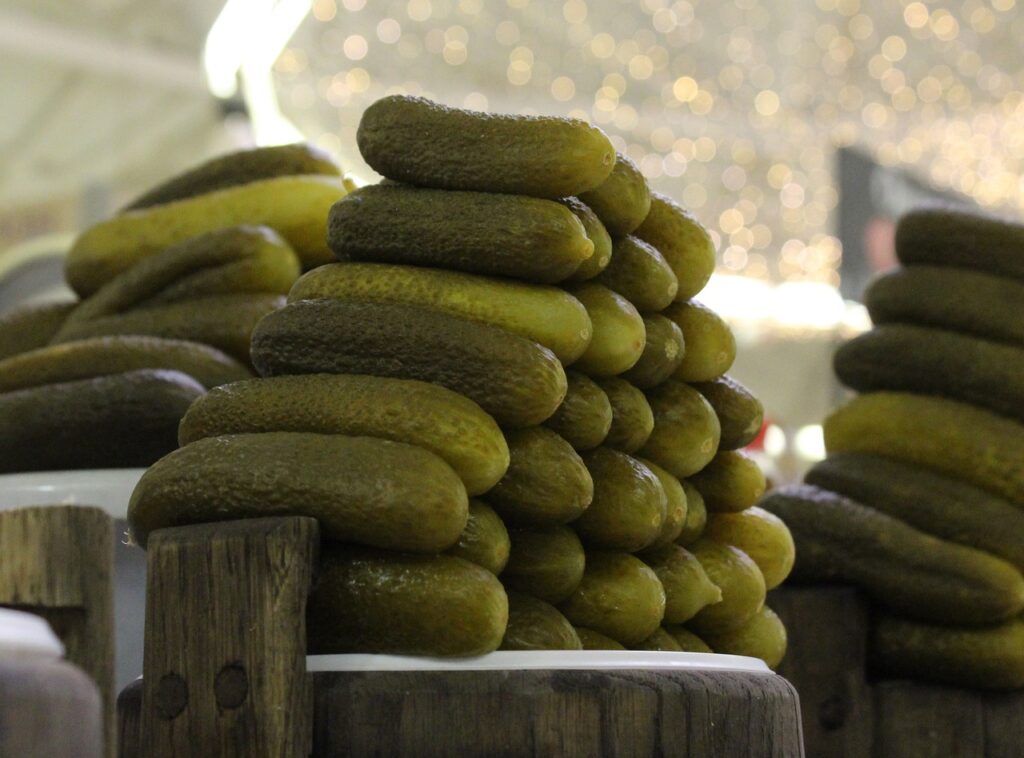Table of Contents
Pickles are a beloved food item enjoyed across the world. Whether they are crisp dill pickles in North America, tangy kimchi in Korea, or spicy achaar in India, pickles have been a part of human cuisine for centuries. What makes pickles unique is not just their flavors but the fascinating process by which they are created – fermentation. In this essay, we will explore the world of pickles, with a specific focus on the science and art of fermentation.
The Origins of Pickles
To understand pickles, we must first look at their origins. Pickling, as a method of food preservation, dates back thousands of years. Ancient civilizations, such as the Mesopotamians and Egyptians, used brine solutions to preserve cucumbers and other vegetables. The term “pickle” itself is derived from the Dutch word “pekel” and German “pókel,” both of which refer to the brining or pickling process.
Is Pickling the Same as Fermenting?
Pickling and fermenting are two distinct preservation techniques that enhance the nuanced flavors of food. Often associated with their bright, tangy, and sour profiles, pickled and fermented foods are sometimes erroneously grouped together. However, while they share certain similarities, they differ significantly in their preparation processes. In the following sections, we will dissect the distinctions between pickling and fermenting, delving into the intricacies of each preservation method.
The Science of Fermentation
A. The Role of Microorganisms
At the heart of pickle fermentation is the role of microorganisms, specifically lactic acid bacteria. These beneficial bacteria are naturally present on the surfaces of fruits and vegetables. When these vegetables are submerged in a brine solution, the lactic acid bacteria initiate the fermentation process. This happens through a series of chemical reactions.
B. Lactic Acid Fermentation
Lactic acid fermentation is the primary process responsible for transforming cucumbers or other vegetables into pickles. During this fermentation, sugars present in the vegetables are converted into lactic acid by the lactic acid bacteria. This drop in pH due to the accumulation of lactic acid is what gives pickles their characteristic tangy flavor. The increase in acidity also acts as a natural preservative, preventing the growth of harmful bacteria.
C. Controlled Environment
Creating the perfect environment for fermentation is crucial. Temperature, salt concentration, and time play significant roles in controlling the fermentation process. In Canada, where temperature variations can be substantial, many pickle makers use fermentation crocks or jars to ensure a consistent and controlled environment. The temperature should ideally be between 70°F to 75°F (21°C to 24°C) for optimal lactic acid bacterial activity.
Types of Pickles
A. Dill Pickles
In Canada, dill pickles are a favorite. They are typically made from cucumbers, garlic, dill, and a brine solution. The fermentation process gives them their characteristic sour and savory flavor. Dill pickles can be enjoyed on their own, as a snack, or as a side dish.
B. Bread and Butter Pickles
These sweet and tangy pickles are a popular choice for sandwiches and burgers. They are made from cucumbers, onions, and a brine that includes sugar and spices. While still undergoing fermentation, they are sweeter compared to dill pickles due to the added sugar.
C. Kosher Pickles
Kosher pickles are a particular type of dill pickle known for their crispness and strong garlic flavor. They are traditionally made with whole cucumbers and a mix of garlic, dill, and kosher salt. The name “kosher” refers to the traditional Jewish method of making these pickles.
D. Kimchi
Although not native to Canada, kimchi deserves mention due to its popularity worldwide. Kimchi is a traditional Korean pickle made from fermented cabbage or radishes, combined with a spicy chili paste and various seasonings. It undergoes a different fermentation process than cucumber pickles but shares the same principle of using beneficial bacteria.
The Art of Pickle Making
A. Variety of Ingredients
One of the artistry aspects of pickle making is the wide variety of ingredients and flavors you can experiment with. While traditional recipes exist, pickle makers often personalize their creations by adding unique spices, herbs, or even fruits to the mix. The result is a diverse range of flavors that cater to different tastes.
B. Timing and Texture
Perfecting the texture of pickles is an art form. Some prefer their pickles crisp and slightly crunchy, while others like them softer and more tender. The timing of when you remove the pickles from the fermentation process can make a significant difference in their texture.
C. Presentation and Aesthetics
The art of pickle making extends to presentation. Many pickle makers take pride in the visual appeal of their creations. Pickles can be arranged attractively in jars, and the choice of container, whether it’s a classic mason jar or a decorative crock, can add to the aesthetic appeal.
The Cultural Significance of Pickles
A. Canada’s Pickle Traditions
In Canada, pickles hold cultural significance, particularly in Eastern European communities where pickle making is a cherished tradition. Many families have their own recipes passed down through generations. The act of pickle making often brings families and communities together, fostering a sense of identity and continuity.
B. Global Impact
Beyond Canada, pickles have a global impact. They are a staple in various world cuisines. For instance, sauerkraut, a type of fermented cabbage pickle, is a beloved ingredient in German cuisine. Likewise, pickled mangoes and other fruits are popular in Indian and Southeast Asian cuisines.
Pickling vs. Fermenting
Multiple mason jars brimming with an array of vibrantly colored fermented and pickled vegetables. The key disparity between pickling and fermenting lies in how they achieve their sour flavor profiles. Pickled foods acquire their sourness through immersion in an acidic brine, whereas fermented foods develop their tangy taste through a complex chemical interaction between naturally occurring sugars and bacteria. It’s important to note that there exists a difference between quick pickles and lacto-fermented pickles, which we will elaborate on shortly. Both pickling and fermenting can be executed using canning or mason jars.
What is Pickling? Pickling is a preservation method that involves submerging foods in an acidic liquid. Basic quick pickling utilizes a brine composed of water, vinegar, pickling salt, and, optionally, pickling spices or aromatic elements such as fresh herbs, citrus rinds, and garlic to enhance the flavor of the pickled foods. If you choose the Lactic Acid Fermentation method, your brine should exclude acidic components and consist solely of water, salt, and any additional flavorings you desire.
In essence, pickling involves creating an acidic environment that prevents the growth of harmful microorganisms while preserving the texture and flavor of the food. The acidity not only acts as a preservative but also imparts the characteristic tartness that pickled foods are known for. This method is ideal for producing items like classic cucumber pickles, pickled onions, or even pickled peppers, each boasting its unique blend of flavors and textures.
On the other hand, lacto-fermented pickles, which fall under the broader category of pickling, rely on the natural lactobacillus bacteria present on the vegetables to initiate the fermentation process. In this case, the brine serves primarily to provide the necessary environment for the beneficial bacteria to thrive and transform the sugars within the vegetables into lactic acid, resulting in a distinct sourness.
Where They Overlap
As previously mentioned, both pickles and many fermented foods share a common starting point: a brine. Consequently, they can be considered as a type of pickle – specifically, fermented pickles. Take sauerkraut, for example; it’s crafted by packing cabbage with salt and allowing it to undergo fermentation. Similarly, traditional dill pickles come to life through the fermentation of cucumbers immersed in briny water. Even kimchi, with its delightful blend of ingredients like cabbage, radish, garlic, anchovy, and chile, relies on salt as a fundamental component.
You might wonder why traditional dill pickles and sauerkraut possess that distinctive tartness, despite the absence of vinegar in their recipes. This sourness is a result of the acids produced by bacteria during the fermentation process, making many fermented foods inherently acidic.
However, it’s important to note that not all fermented foods can be classified as pickles. Sourdough bread, beer, and yogurt, for instance, are prime examples of fermented foods that don’t fall into the pickle category.
Conversely, not all pickles are fermented! Another method for making pickles involves pouring hot vinegar over vegetables. These quick pickles, commonly found in commercial varieties, typically do not undergo fermentation.
In summary, fermented foods offer a range of established health benefits thanks to the presence of beneficial bacteria, and the fermentation process enriches their flavors. Whenever possible, consider seeking out artisanal producers who adhere to the traditional, fermented approach when making pickles. Better yet, explore the rewarding experience of crafting your own fermented pickles.
Creating Mildly Tangy Lacto-Fermented Pickles
Author’s Note: If you’re new to pickle making, I recommend starting with a small batch to ease into the process. Approximately 8 to 10 cucumbers that fit snugly in a one-quart jar should suffice.
Ingredients:
- 8–10 pickling cucumbers per jar (See notes below for tips on selecting the best pickling cucumbers.)
- 2 teaspoons peppercorns
- 2 dill flower heads or 2 tablespoons dill seeds
- 3–6 cloves of whole garlic, peeled and gently smashed Optional Ingredients:
- 1 bay leaf
- 1 tablespoon mustard seeds
- A couple of unsprayed grape leaves*, rinsed (*Author’s Note: I use unsprayed grape leaves to maintain pickle crispness and keep them submerged in the brine. One leaf goes at the bottom, and another on top of the cucumbers.)
- Dried or crushed hot peppers, to taste
Equipment:
- 1–3 glass wide-mouth canning jars with lids and rings (unless using plastic) (*Author’s Note: For fermentation, I prefer one-piece plastic lids.)
Brine Ingredients:
- 2 tablespoons kosher salt
- 4 cups non-chlorinated or filtered water (*Author’s Note: Ensure your water lacks chlorine or impurities that could hinder fermentation. Adjust quantities if making larger batches.)
Selecting the Perfect Pickling Cucumbers:
- Choose fresh cucumbers and keep them chilled if not pickling immediately.
- Trim the blossom end before preparing.
- Opt for cucumber sizes that suit your preference; cucumbers bred for pickling work best.
Directions:
Thoroughly wash the cucumbers with cold water, removing any discolored, bruised, or soft ones. Ensure they are unwaxed. Optionally, soak them in an ice bath for 1 to 2 hours before pickling for best results.
Prepare the brine by bringing the water to a boil and adding the kosher salt. Use non-chlorinated or filtered water to prevent minerals or chlorine from inhibiting fermentation. Stir until the salt dissolves, then set the brine aside to cool.
Trim the blossom end of the cucumbers, or both ends if necessary. You can slice them or leave them whole, depending on your preference.
In each jar, place a grape leaf (or two) at the bottom, followed by the spices.
Pack the cucumbers into the jars snugly, leaving at least ¼ inch of headspace to ensure they’re covered by the brine. Packing them tightly helps prevent floating during fermentation. Add an extra grape leaf on top or a cucumber wedge to keep them submerged. This top cucumber can serve as your initial taste test if necessary. Specialized accessories like glass weights can also aid in keeping cucumbers submerged, but they’re not essential for occasional pickling.
Once the brine has cooled to room temperature, pour it over the cucumbers. Secure a plastic canning lid onto the jar, leaving it loosely screwed, and place it on a countertop for fermentation. For beginners, it’s advisable to pick a location where you’ll regularly see the jar to ensure you don’t forget about it. Ideally, the room temperature should be below 77°F (25°C). Warmer temperatures expedite fermentation, while colder temperatures may hinder the process.
Daily, release gas from the pickle jar by loosening the lid (burping) and then reseal it, avoiding overtightening to prevent pressure buildup. Specialized lids with gas-release attachments can be convenient for frequent fermenters but may not be necessary for occasional use.
After 3 to 4 days in a 77°F room, or 7 to 10 days in cooler conditions, taste the pickles to gauge their flavor. Continue fermenting on the countertop until they reach your desired level of sourness, then transfer them to the refrigerator to slow down fermentation. Consume the pickles within a month, noting that their color will change as they ferment.
Who would have thought that crafting these mildly tangy snacks and sandwich companions could be so straightforward and beneficial for your gut health? If your Ixcela gut health test indicates a need for boosting indole-3-propionic acid, indole-3-lactic acid, or indole-3-acetic acid, consider adding fermented pickles to your diet. If you develop a taste for them, don’t limit yourself to cucumbers; a variety of vegetables can be pickled using a similar method, enhancing flavors and complementing meals. Whether you choose to create your own or purchase them from a trusted pickling expert at the farmers market, rest assured that you’ll be introducing a healthy dose of friendly bacteria into your diet.
Conclusion
In conclusion, pickles are more than just a tasty condiment or snack; they are a result of the fascinating science of fermentation and the artistry of pickle makers. Whether you enjoy the crispness of dill pickles, the sweetness of bread and butter pickles, or the bold flavors of kimchi, pickles have a place in the hearts and palates of people worldwide.
Canada’s rich pickle traditions, along with its multicultural influence, contribute to the diversity of pickle recipes and flavors found in the country. The next time you savor a pickle, remember the intricate dance of microorganisms and the culinary creativity that goes into making this beloved food item.





